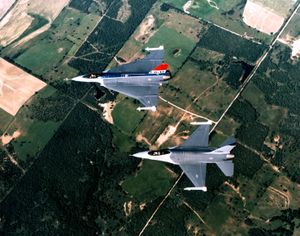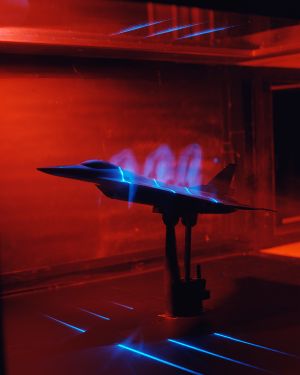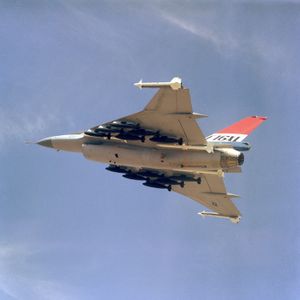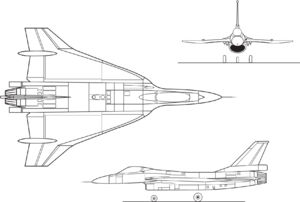PlaneSpottingWorld welcomes all new members! Please gives your ideas at the Terminal.
General Dynamics F-16XL
| F-16XL | |
|---|---|
| F-16XL in flight | |
| Type | Experimental fighter |
| Manufacturer | General Dynamics |
| Primary users | United States Air Force NASA |
| Number built | 2 |
| Developed from | F-16 Fighting Falcon |
The General Dynamics F-16XL is a derivative of the F-16 Fighting Falcon, with a cranked-arrow delta wing that is over twice the size of that of the standard F-16 wing. It was entered in the U.S. Air Force's Enhanced Tactical Fighter (ETF) competition but ultimately lost to the F-15E Strike Eagle. Several years after the prototypes were shelved, they were turned over to NASA for aeronautical study.
Contents
History
Enhanced Tactical Fighter competition
In 1977, the F-16XL started out as the F-16 SCAMP (Supersonic Cruise and Maneuvering Program) at General Dynamics Fort Worth. Under the leadership of Harry Hillaker, the original goal of the program was to demonstrate the applicability of Supersonic transport technologies to military aircraft. Working closely with NASA's Langley Research Center, the company invested significant Internal Research and Development (IRAD) funds for wind tunnel testing and that led to an extensive preliminary design effort by 1978.
In 1980, the USAF signed on as a partner, providing two early model F-16s for conversion (the third and fifth production airframes). In March of 1981, the USAF announced the Enhanced Tactical Fighter program to procure a replacement for the F-111 'Aardvark'. The concept envisioned an aircraft capable of launching deep interdiction missions without requiring additional support in the form of fighter escort or jamming support. General Dynamics submitted the F-16XL, while McDonnell Douglas submitted a variant of the F-15 Eagle. In February of 1984, the USAF awarded the ETF to McDonnell Douglas (which resulted in the F-15E Strike Eagle), and both F-16XL aircraft were returned to the Air Force and placed in storage.
NASA
In 1988, the two airplanes were taken out of storage and turned over to NASA for research. The first aircraft was fitted with an active suction titanium glove encasing the left wing and delivered to the Ames-Dryden Flight Research Facility at Edwards AFB. Designed and built by North American Aviation (a division of Rockwell International), the glove had laser-cut holes that were nominally 0.0025 in (0.0635 mm) diameter. Distance between holes varied between 0.010 and 0.055 in (0.25 and 1.40 mm) depending on the suction. The glove covered over five square feet (0.5 m²) of the wing. It was intended to suck away turbulent airflow over the wing, restoring laminar flow and reducing drag. The aircraft was also involved in testing sonic boom characteristics, takeoff performance, and engine noise, for NASA's civil transport program.
The second aircraft (a two seater) had its experimental engine replaced with a General Electric F110-129. It accidentally achieved supercruise, a design goal of the F-16XL that was never attained in ETF testing, when it reached Mach 1.1 at 20,000 feet (6 km) on full military power. It was mounted with a passive fiberglass and foam glove on the right wing to examine supersonic flow, and an active glove on the left wing. This second glove was composed of fiberglass and foam over a titanium skin, and covers 75% of the wing's surface and 60% of its leading edge. The active portion consists the middle two-thirds of the glove, with laser-drilled holes leading to cavities beneath the wing. It was designed collaboratively by Langley research center, Dryden, Rockwell, Boeing, and McDonnell Douglas. The glove is intended as a testbed for supersonic laminar flow.
Design characteristics
The wing and rear horizontal control surfaces were replaced with a cranked-arrow delta wing 120% larger than the original wing. Extensive use of carbon composites allowed the savings of 600 lb (270 kg) of weight but the F-16XL was still 2,800 lb (1300 kg) heavier than the original.
Less noticeable is that the fuselage was lengthened by 56 inches (1.4 m) by the addition of 2 sections at the joints of the main fuselage sub-assemblies. With the new wing design, the tail section had to be canted up 3 degrees, and the ventral fins removed, to prevent them from striking the pavement during takeoff and landing. However, as the F-16XL exhibits greater stability than the native F-16, these changes were not detrimental to the handling of the aircraft.
These changes resulted in a 25% improvement in maximum lift-to-drag ratio in supersonic flight and 11% in subsonic flight, and a plane that reportedly handled much smoother at high speeds and low altitudes. The enlargements increased fuel capacity by 82%. The F-16XL could carry twice the ordnance of the F-16 and deliver it 40% further. The enlarged wing allowed a total of 27 hardpoints on the plane:
- 16 wing stations of capacity 750 lb (340 kg) each
- 4 semi-submerged AMRAAM stations
- 2 wingtip stations
- 1 centerline station
- 2 wing "heavy/wet" stations
- 2 chin LANTIRN stations
However, the "heavy/wet" stations interfered with up to 4 wing stations
Specifications (F-16XL number 2)
General characteristics
- Crew: 2
- Length: 54 ft 2 in (16.51 m)
- Wingspan: 34 ft 3 in (10.44 m)
- Height: 17 ft 7 in (5.36 m)
- Wing area: 633 ft² (58.8 m²)
- Empty weight: 22,000 lb (9,980 kg)
- Max takeoff weight: 48,000 lb (22,000 kg)
- Powerplant: 1× General Electric F110-GE-129 turbofan
- Dry thrust: 17,155 lbf (76.3 kN)
- Thrust with afterburner: 28,984 lbf (128.9 kN)
Performance
- Maximum speed: Mach 2.0
- Range: 2,480 nm (2,850 mi, 4,590 km)
- Service ceiling: 50,000 ft (15,000 m)
- Rate of climb: 62,000 ft/min (315 m/s)
External links
Related content
Related development
Comparable aircraft
Designation sequence
Related lists
See also
Lists relating to aviation | |
|---|---|
| General | Timeline of aviation · Aircraft · Aircraft manufacturers · Aircraft engines · Aircraft engine manufacturers · Airports · Airlines |
| Military | Air forces · Aircraft weapons · Missiles · Unmanned aerial vehicles (UAVs) · Experimental aircraft |
| Notable incidents and accidents | Military aviation · Airliners · General aviation · Famous aviation-related deaths |
| Records | Flight airspeed record · Flight distance record · Flight altitude record · Flight endurance record · Most produced aircraft |





